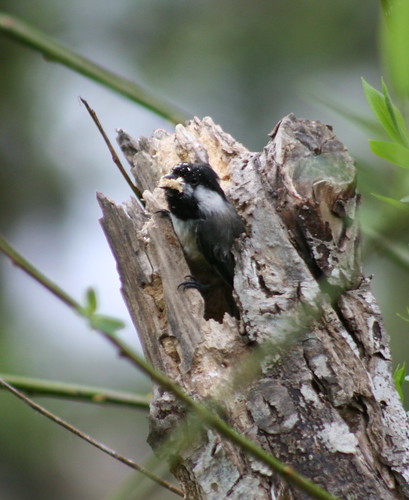Now that spring is in full-swing, Capitol Hill’s avian residents are busy constructing nests. On a recent walk in Nora’s woods, a tiny neighborhood park on 29th and Columbia in the Central District, I spotted a pair of black-capped chickadees busily flying into and out of a hollow tree branch. Both birds repeatedly emerged from the hole with beaks full of wood and debris, which they dropped on the ground. This is a behavior called nest hole excavation, and it’s the chickadee’s first step in preparing a site for laying eggs and raising chicks.
Last month, we wrote about bird love. Now it’s time to make a home.
Black-capped chickadees are one of Capitol Hill’s most common birds. They’re highly distinctive with their black-and-white striped heads, their chickadee-dee-dee calls, and their acrobatic feeding style. During the winter, black-capped chickadees live in flocks, but in spring, they become territorial.
Chickadees nest in knotholes or nest holes that have been previously used by other animals. Both members of the pair participate in nest site excavation before the female builds the nest using materials such as moss and fur. If you happen to notice chickadees excavating a nest site, keep an eye on that spot. Chicks may appear in about three to five weeks.
Out in nature, chickadees usually nest in different spots every year. Where appropriate sites are more limited — such as here around Capitol Hill — pairs may reuse the same holes repeatedly. A neighbor in Nora’s Woods said he’d previously seen black-capped chickadees using the hole I spotted.
Nest excavation is such an ingrained behavior in black-capped chickadees that they’re unlikely to move into a hole if they find it too clean and well-groomed. If you keep birdhouses in your yard and want to attract chickadees to it, put a few wood chips inside to give them something to remove.
Interested in Learning More?
For information and fun facts about black-capped chickadees, check out their page at the Cornell Lab of Ornithology.
Here’s a recording of the black-capped chickadee’s distinctive song, and a separate recording of its call. If the chickadees in your yard don’t sound like these recordings, never fear. Our Pacific Northwest chickadees have highly variable vocalizations. ![]()




This is a great time to hang out in the P-Patch on Thomas St. just off Broadway. There are chickadees everywhere due to the seeds on overwintered plants, as well as mating pairs of nuthatches and flocks of hungry bushtits. They’re all so focused on going for seeds and flying bugs that they’ll buzz within inches of your head.
Thanks for the tip, I walk by there daily. Next time I will slow down to watch awhile
On my balcony on Belmont, we have a feeder, and in addition to the chicadees, we’ve been getting a lot of finches, red and golden. Its porno for our cats.
Thanks for the tip. I’ll check that out during my research for these posts!
What are the birds that have those two-note songs? They sing in the early morning and later afternoon around here. They go “dew-dew, dew-dew,” and it sounds downbeat.
Hard to say for sure what you’re hearing, but a chickadee is a decent bet from this description:
http://macaulaylibrary.org/audio/105762/poecile-atricapillus
They are one of our favorite winter birds, oving the snow and surviving cold temps; don’t see them as much in the summer at our feeders.
Really? That’s interesting. We get them all year.
Thanks for checking in, Lana!